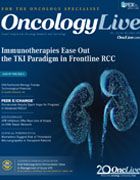Direct Oral Anticoagulants Signal Change in VTE Prevention
Investigators at Cleveland Clinic have demonstrated that the direct oral anticoagulant rivaroxaban significantly reduces venous thromboembolism (VTE) and VTE-related death for patients with high-risk cancers treated in the outpatient setting.

Alok A. Khorana, MD
Investigators at Cleveland Clinic have demonstrated that the direct oral anticoagulant rivaroxaban (Xarelto) significantly reduces venous thromboembolism (VTE) and VTE-related death for patients with high-risk cancers treated in the outpatient setting.
Many patients with cancer are at extended risk for VTE, and following surgery or hospitalization, most patients are monitored for warning signs of blood clots in their lower extremities; however, that same level of monitoring and care has not extended to the outpatient setting.
The phase IIIB CASSINI trial (NCT02555878) evaluated the safety and efficacy of rivaroxaban in the outpatient setting in high-risk, ambulatory patients with various cancer types, making it the first study to evaluate intervention with direct oral anticoagulants over an extended period in patients with cancer (Figure 1).1
Routine thromboprophylaxis is not recommended in current guidelines, and nearly 80% of clots related to cancer care now occur in the outpatient setting, according to Alok Khorana, MD, who led the multicenter trial. “A number of studies have evaluated whether outpatient thromboprophylaxis could be successful in preventing clots following cancer care without substantially increasing the risk of bleeding,” said Khorana, vice-chair for Clinical Services of the Taussig Cancer Institute and Director of the Gastrointestinal Malignancies Program at the Cleveland Clinic in an interview with OncologyLive®.
Trial Design
In CASSINI, patients were evaluated prior to chemotherapy initiation for VTE using a 0 to 6 scoring system designed by Khorana. The Khorana score uses 5 predictive variables, including type of cancer, to identify patients at risk for symptomatic VTE (Figure 2). Patients with a score ≥2 are considered high risk.2
Those without deep vein thrombosis (DVT) at initial screening were randomized to receive rivaroxaban or placebo daily for up to 180 days, with screening every 8 weeks. The primary efficacy endpoint is first occurrence of DVT in a lower limb, pulmonary embolism, symptomatic DVT in an upper limb or distal DVT in a lower limb, and death from VTE. The primary safety endpoint is major bleeding.
At baseline screening, 49 (4.5%) of 1080 enrolled patients had evidence of thrombosis and were placed in the rivaroxaban group. Among the 841 patients who underwent randomization, primary endpoints were reached in 25 of 420 (6.0%) in the rivaroxaban group and 37 of 421 (8.8%) in the placebo group (HR, 0.66; 95% CI, 0.40-1.09; P = .01).2
Figure 1. Preventive Use of Direct Oral Anticoagulants in Patients With Cancer1CASSINI Trial (NCT02555878)
During the intervention period (first receipt of the trial agent to last dose plus 2 days), blood clots occurred in 2.6% of patients receiving rivaroxaban compared with 6.4% of patients in the placebo group. During the full study period, which included up to 180 days of follow-up even if medication was stopped early, the gap narrowed, with clots occurring in 6.0% of patients versus 8.8%, respectively. Investigators at Cleveland Clinic said the results after the full study period—which included follow-up up to 180 days—showed that mortality was lower among patients taking rivaroxaban (23.1%) versus placebo (29.5%) for the combined endpoint of all-cause death and VTE. Major bleeding occurred in less than 2% of patients, which is normal for prophylactic anticoagulation in patients with cancer.
The findings of the CASSINI trial were consistent with those of 2 prior studies (PROTECHT, NCT00951574; SAVE-ONCO, NCT00694382) evaluating whether outpatient thromboprophylaxis could be successful in preventing clots in the outpatient setting when treated with lowmolecular-weight heparin (LMWH). Rivaroxaban showed an advantage over LMWH, with an absolute difference in risk nearly doubled in the CASSINI trial (4.0 percentage points vs 1.9 in the PROTECHT trial and 2.2 in the SAVE-ONCO trial), despite the exclusion of 4.5% of patients who presented with DVT.2
The lower rate of events in both the arterial and distal asymptomatic events, although not included in the primary endpoint, could support the net benefit offered by prophylaxis for high-risk patients with cancer.
Figure 2. Khorana Thromboembolic Risk Score
Translating Prevention to the Outpatient Setting
A sister trial, AVERT (NCT02048865), led by Carrier et al in Canada, reported a similar conclusion. The trial evaluated the efficacy and safety of apixaban (Eliquis), another direct oral anticoagulant class drug, in patients identified as high risk for VTE. VTE occurred in 4.2% (n = 288) of patients in the apixaban therapy arm versus 10.2% (n = 275) in the placebo arm (HR, 0.41; 95% CI, 0.26-0.65; P <0.001).3
“Patients with cancer can have complications, such as blood clots, from cancer itself or from cancer treatment,” Khorana said in a statement.1 Because most cases of VTE and DVT are prevented in other settings, “these complications are distressing for patients, may delay treatment, and contribute to emergency department visits and hospitalizations, which impact healthcare utilization and costs,” he added.
One difference in both the PROTECHT and SAVE-ONCO trials was that each used LMWH. The drug is administered by a daily self-injection, and patients require frequent monitoring. “Physicians and patients already carry a high burden of treatment discussion about treatment itself as well as the management of the adverse effects and so on. To ask [patients with cancer] to take a daily injection on top of everything else that you’re already asking them to do was perceived as too much,” Khorana said.
Detecting High-Risk Patients Early
The CASSINI results show the benefit of treating patients at high risk for developing clots in the outpatient setting, but assessment of risk and patient—doctor communication are 2 areas that Khorana said need more development.
“Better risk assessment strategies are needed, and while these trials prove that the [Khorana] risk score is a good way to identify the high-risk patients, we could be better about finding even higher-risk patients,” Khorana said. Recently, he and his colleagues were funded by the National Institutes of Health to identify novel biomarkers that could be used to identify super-high-risk patients, but that research is in early stages and will take several years to complete.
Regarding patient education, managing adverse events is foremost in mind for oncologists and patients. After the cancer itself, the second-leading cause of death in ambulatory patients with cancer is VTE. “We are really good about discussing risk of hair loss and nausea and vomiting and neutropenia risk of infection and so on, but for some reason, the risk of having clots occur on treatment has not attracted the attention it deserves,” Khorana said.
Rivaroxaban is not currently recommended by the National Comprehensive Cancer Network guidelines for the treatment of cancer-associated VTE, except on a case-by-case basis. Based on the study results, Khorana is hopeful that the treatment landscape will change to include direct oral anticoagulants for outpatient prophylaxis. “I think you will see that guidelines are going to include these studies in the recommendations and that you will find greater utilization of primary prevention strategies,” Khorana said.
References
- Cleveland Clinic-led research finds rivaroxaban significantly reduces blood clots and blood clot-related death in cancer patients [news release]. Cleveland, OH: Cleveland Clinic; February 21, 2019. newsroom.clevelandclinic.org/2019/02/21/cleveland-clinic-led-research- finds-rivaroxaban-significantly-reduces-blood-clots-and-bloodclot- related-death-in-cancer-patients. Accessed March 18, 2019.
- Khorana AA, Soff GA, Kakkar AK, et al; CASSINI Investigators. Rivaroxaban for thromboprophylaxis in high-risk ambulatory patients with cancer. N Engl J Med. 2019;380(8):720-728. doi: 10.1056/ NEJMoa1814630.
- Carrier M, Abou-Nassar K, Mallick R, et al; AVERT Investigators. Apixaban to prevent venous thromboembolism in patients with cancer. N Engl J Med. 2019;380(8)711-719. doi: 10.1056/NEJMoa1814468.




